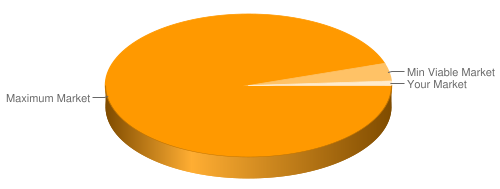Marc Andreessen suggests the most important characteristic to predicting successful startups is market.
In a great market -- a market with lots of real potential customers -- the market pulls product out of the startup.
The market needs to be fulfilled and the market will be fulfilled, by the first viable product that comes along.
The product doesn't need to be great; it just has to basically work. And, the market doesn't care how good the team is, as long as the team can produce that viable product.
Minimum Viable market is a continuation of the ideas I discussed in the elusive nature of success. What market is sufficient to sustain a business, and how can an entrepreneur or content creator build on that market once equilibrium is achieved. Kevin Kelly has revisited his postulate that in today's market, a content creator, artist, or small company needs only 1000 true fans.
A true fan is someone who would buy whatever you produced during the year, and would spend say at least $50 on your stuff, go to every one of your shows, or signings, purchase anything you produced. If the independent artist dealt directly with these fans, getting most of what they paid (unlike the deal under publishers, labels, studios, galleries) then the arithmetic suggested an artist could, in theory, need no more than 1,000 fans to make a $50,000 living.
That was the theory. The question was, were there any stars of 1,000 true fans? Was anyone actually doing this? My friend Jaron Lanier threw up an even more realistic challenge: were there any examples of artists surviving on direct fans who did not migrate from some kind of success with "old media" first? In other words, do we see any a true-fan supported indie artist going digital first?
Back then in 2008, I could only find three artists who might have qualified. I felt that it was still a little earlier because this process would almost by definition, take time to cultivate.
Now several years later I can point to a whole pile of creative people who are making a good living independent of traditional media mediators, who are living directly off their fans.
The biggest star these days is Amanda Hocking, who is selling 100,000 ebooks on Kindle per month, and keeping most of that money ($3-5 retail). (FYI, her books are low-brow vampire Twilight knockoffs.) As one publisher whispered online: "there is no traditional publisher in the world right now that can offer Amanda Hocking terms that are better than what she’s currently getting, right now on the Kindle store, all on her own."
A minimal sustainable market can range from one client to hundreds of millions of customers depending on margins and the duration of the relationship. An individual can survive easily with a single true fan which nets the content creator $50k per year, but the content creator or business is highly dependent on having at least one true fan all year.
This situation is similar to employment with the difference being the direction of work coming from the individual instead of an employer. Consultants serve a number of clients to generate enough income to comfortably survive, and have moderate flexibility (depending on market and reputation) in the types of jobs they select. Alternatively a content creator could be a smashing success for only a couple of months and generate enough profit to live comfortably indefinitely, but this is the exception not the rule.
As founders or self sufficient content creators we need to understand who composes our minimum viable market, and whether we can reasonably expect to grow a profitable business in that area. Market sizing is essential for entrepreneurs who wish to disrupt and navigate large dynamic markets. Even a small or solitary business' survival is incumbent on understanding the values of the market they serve.
Perhaps a more appropriate term for right sizing a market is minimax viable market.
Minimax (sometimes minmax) is a decision rule used in decision theory, game theory, statistics and philosophy for minimizing the possible loss while maximizing the potential gain. Alternatively, it can be thought of as maximizing the minimum gain (maximin).
Related posts on marketing:
